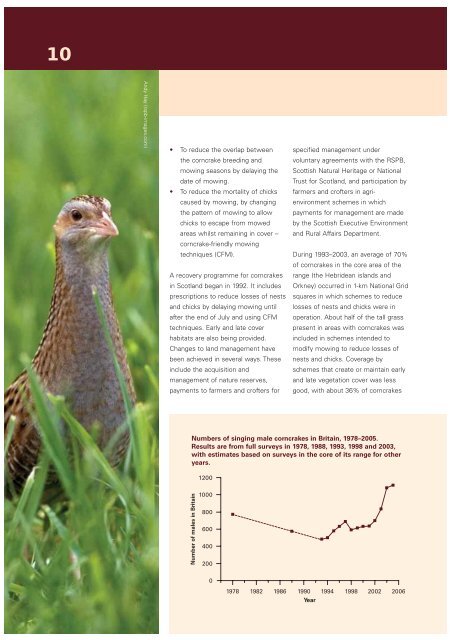Conservation Science in the RSPB 2006
Conservation Science in the RSPB 2006
Conservation Science in the RSPB 2006
Create successful ePaper yourself
Turn your PDF publications into a flip-book with our unique Google optimized e-Paper software.
10<br />
Andy Hay (rspb-images.com)<br />
• To reduce <strong>the</strong> overlap between<br />
<strong>the</strong> corncrake breed<strong>in</strong>g and<br />
mow<strong>in</strong>g seasons by delay<strong>in</strong>g <strong>the</strong><br />
date of mow<strong>in</strong>g.<br />
• To reduce <strong>the</strong> mortality of chicks<br />
caused by mow<strong>in</strong>g, by chang<strong>in</strong>g<br />
<strong>the</strong> pattern of mow<strong>in</strong>g to allow<br />
chicks to escape from mowed<br />
areas whilst rema<strong>in</strong><strong>in</strong>g <strong>in</strong> cover –<br />
corncrake-friendly mow<strong>in</strong>g<br />
techniques (CFM).<br />
A recovery programme for corncrakes<br />
<strong>in</strong> Scotland began <strong>in</strong> 1992. It <strong>in</strong>cludes<br />
prescriptions to reduce losses of nests<br />
and chicks by delay<strong>in</strong>g mow<strong>in</strong>g until<br />
after <strong>the</strong> end of July and us<strong>in</strong>g CFM<br />
techniques. Early and late cover<br />
habitats are also be<strong>in</strong>g provided.<br />
Changes to land management have<br />
been achieved <strong>in</strong> several ways. These<br />
<strong>in</strong>clude <strong>the</strong> acquisition and<br />
management of nature reserves,<br />
payments to farmers and crofters for<br />
specified management under<br />
voluntary agreements with <strong>the</strong> <strong>RSPB</strong>,<br />
Scottish Natural Heritage or National<br />
Trust for Scotland, and participation by<br />
farmers and crofters <strong>in</strong> agrienvironment<br />
schemes <strong>in</strong> which<br />
payments for management are made<br />
by <strong>the</strong> Scottish Executive Environment<br />
and Rural Affairs Department.<br />
Dur<strong>in</strong>g 1993–2003, an average of 70%<br />
of corncrakes <strong>in</strong> <strong>the</strong> core area of <strong>the</strong><br />
range (<strong>the</strong> Hebridean islands and<br />
Orkney) occurred <strong>in</strong> 1-km National Grid<br />
squares <strong>in</strong> which schemes to reduce<br />
losses of nests and chicks were <strong>in</strong><br />
operation. About half of <strong>the</strong> tall grass<br />
present <strong>in</strong> areas with corncrakes was<br />
<strong>in</strong>cluded <strong>in</strong> schemes <strong>in</strong>tended to<br />
modify mow<strong>in</strong>g to reduce losses of<br />
nests and chicks. Coverage by<br />
schemes that create or ma<strong>in</strong>ta<strong>in</strong> early<br />
and late vegetation cover was less<br />
good, with about 36% of corncrakes<br />
Numbers of s<strong>in</strong>g<strong>in</strong>g male corncrakes <strong>in</strong> Brita<strong>in</strong>, 1978–2005.<br />
Results are from full surveys <strong>in</strong> 1978, 1988, 1993, 1998 and 2003,<br />
with estimates based on surveys <strong>in</strong> <strong>the</strong> core of its range for o<strong>the</strong>r<br />
years.<br />
1200<br />
Number of males <strong>in</strong> Brita<strong>in</strong><br />
1000<br />
800<br />
600<br />
400<br />
200<br />
0<br />
1978 1982 1986 1990 1994 1998 2002 <strong>2006</strong><br />
Year

















